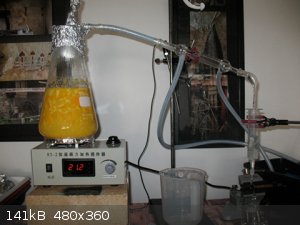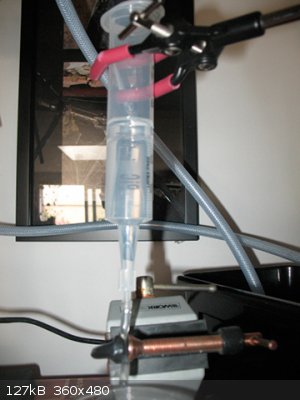CHRIS25
National Hazard
   
Posts: 951
Registered: 6-4-2012
Location: Ireland
Member Is Offline
Mood: No Mood
|
|
Distillation Successes
Original yields of Limonene were between 1.5 - 3 mLs on the first 4 attempts using average of 10 -12 medium sized Spanish valencias.
But this final yield has already collected 8 mLs in the syringe and is not finished. Why the big difference? Well I made three changes:
1. I lengthened the tube between the condenser and the still,
2. I turned the actual still upside down to take advantage of the bigger opening going into the 2 litre flask,
3. I changed from Spanish to south african valencias due to a snippet of information stumbled upon in a technical paper.
Whether or not all 3 of the above or just 2 of the above had an effect I do not know, but after4 distillations this jump in yield is significant
enough.
The Rosemary oil was also a success, 400 grams yielded 3 mLs, but the apparatus used here was a biomass flask and the method of course was via
water/steam distillation, not water distillation as with the oranges.
The separatory funnel is a syringe, with an adapter and a thin tube connected, this latter is clamped via a small table vice as seen in photo.
I wonder if the orange peel could be water/steam distilled (I know this is not conventional), but I could fit three times as much peel into the
biomass flask and I would also not have to go through the tedious task of scraping out the pith and cutting into small chunks and then liquidizing.
Projects include More rosemary, lavender, calendular and camomille, limes lemons and grapefruit, and then a ton of research to delve deeper.
 
‘Calcination… is such a Separation of Bodies by Fire, as makes ‘em easily reducible into Powder; and for that reason ‘tis call’d by some
Chymical Pulverization.’ (John Friend, Chymical Lectures London, 1712)
Right is right, even if everyone is against it, and wrong is wrong, even if everyone is for it. (William Penn 1644-1718)
The very nature of Random, Chance development precludes the existence of Order - strange that our organic and inorganic world is so well defined by
precision and law. (me)
|
|
|
kclo4
National Hazard
   
Posts: 916
Registered: 11-12-2004
Location:
Member Is Offline
Mood: No Mood
|
|
I assume it is orange peels in the flask?
I believe you would see better yields having steam actually hitting the orange peels as opposed to having them boiling in solution. I believe steam
has more energy and transfers it over into the limonene more easily than does the boiling water.
|
|
|
TheChemiKid
Hazard to Others
  
Posts: 493
Registered: 5-8-2013
Location: ̿̿ ̿̿ ̿'̿'̵͇̿̿з=༼ ▀̿̿Ĺ̯̿̿▀̿ ̿ ༽
Member Is Offline
Mood: No Mood
|
|
What temperature did it distill at?
When the police come
\( * O * )/ ̿̿ ̿̿ ̿'̿'̵͇̿̿з=༼ ▀̿̿Ĺ̯̿̿▀̿ ̿ ༽
|
|
|
CHRIS25
National Hazard
   
Posts: 951
Registered: 6-4-2012
Location: Ireland
Member Is Offline
Mood: No Mood
|
|
@Kcio4 I have no idea why, reading so much about this I still do not understand why putting the peels of all citrus fruits in water is the way to do
this. I recognise that the boiling therefore the decomposition of limonene is at 176, so direct steam in this situation should not harm it, but there
are so many complex writ-ups, discussions and explanations about the osmotic pressures and goodness knows what else, I simply can't get my head around
all this. It seems that water is preferred by literally every single lab and home set up I have read about?
@TheChemKid Temeprature? no idea, I can not measure the temp because the still is upside down! But Logic, (if any is to be found in me), says that
since this is boiling water at normal pressure (no vacuum) then the steam has to be not much above 101 c. But the cells in the peel are ruptured at a
water temperature of about 90 c, based on the fact that I get oil just as the water reaches boiling temperature and so Limonene leaks into the water
certainly before 98 c.
‘Calcination… is such a Separation of Bodies by Fire, as makes ‘em easily reducible into Powder; and for that reason ‘tis call’d by some
Chymical Pulverization.’ (John Friend, Chymical Lectures London, 1712)
Right is right, even if everyone is against it, and wrong is wrong, even if everyone is for it. (William Penn 1644-1718)
The very nature of Random, Chance development precludes the existence of Order - strange that our organic and inorganic world is so well defined by
precision and law. (me)
|
|
|
MrHomeScientist
International Hazard
    
Posts: 1806
Registered: 24-10-2010
Location: Flerovium
Member Is Offline
Mood: No Mood
|
|
When I distilled orange oil, I didn't bother removing the pith at all. I simply took the peels and put them in a blender with some water. This ground
everything down to a paste which was then distilled, so I figured getting rid of the pith wouldn't be necessary. I don't have any better info than it
"worked fine" and I got several mL of product from something like 2 big oranges (this was a couple years ago). I seemed to get much less oil when I
didn't blend, and just distilled from the peels.
Interestingly, after maybe 6 months of storage, the oil started smelling 'sour' but the hydrosol still smelled great!
|
|
|
CHRIS25
National Hazard
   
Posts: 951
Registered: 6-4-2012
Location: Ireland
Member Is Offline
Mood: No Mood
|
|
@HomeScientist The pith contains around 10-15% oil, negligible I agree, but including the pith in the liquid in the distillate caused agitation
problems, with so much junk the mass could hardly move, (and this was with a litre of water), even with a 50 cm triangular stir bar designed for
viscous liquids, it would not stir, this allowed for some mass to settle and become caramelized, also, more importantly, one needs movement to create
space for the limonene that is being extracted into the surrounding water. I began with using peel just chopped, then making it smaller, then deciding
to remove the pith and re-organise the whole apparatus. Hence the higher yield now.
‘Calcination… is such a Separation of Bodies by Fire, as makes ‘em easily reducible into Powder; and for that reason ‘tis call’d by some
Chymical Pulverization.’ (John Friend, Chymical Lectures London, 1712)
Right is right, even if everyone is against it, and wrong is wrong, even if everyone is for it. (William Penn 1644-1718)
The very nature of Random, Chance development precludes the existence of Order - strange that our organic and inorganic world is so well defined by
precision and law. (me)
|
|
|
aga
Forum Drunkard
    
Posts: 7030
Registered: 25-3-2014
Member Is Offline
|
|
Not sure if this is on or off-topic :
I appear to have made pretty close to Anhydrous Ethanol from Vodka.
1400ml of Vodka was distilled three times using a Vigreux column.
In the last distillation, i added an addition funnel to the end of the vac adapter, which was simply giving a 90 degree turn to the glass (no vacuum
used).
The funnel was full of dry NaCl - i read that it can dry Ethanol, as it's hygroscopic, and not soluble in ethanol.
Is there is simple test for Water to see if the Ethanol is anhydrous or not ?
|
|
|
macckone
Dispenser of practical lab wisdom
    
Posts: 2168
Registered: 1-3-2013
Location: Over a mile high
Member Is Offline
Mood: Electrical
|
|
Quote: Originally posted by aga  | Not sure if this is on or off-topic :
I appear to have made pretty close to Anhydrous Ethanol from Vodka.
1400ml of Vodka was distilled three times using a Vigreux column.
In the last distillation, i added an addition funnel to the end of the vac adapter, which was simply giving a 90 degree turn to the glass (no vacuum
used).
The funnel was full of dry NaCl - i read that it can dry Ethanol, as it's hygroscopic, and not soluble in ethanol.
Is there is simple test for Water to see if the Ethanol is anhydrous or not ? |
This is not an easy task. Most of the indicators will show slight traces of water with ethanol even if no water is actually present.
Ethanol presents a mild reaction with the indicator.
To get truly anhydrous ethanol, you need to distill over sodium metal
or similar treatment.
|
|
|
aga
Forum Drunkard
    
Posts: 7030
Registered: 25-3-2014
Member Is Offline
|
|
Sodium Metal ! Wow.
Thanks for the pointers.
What 'indicators' do you refer to ?
As i have no sodium metal, and don't really need any anhydrous ethanol, i'll titrate it and see what i got.
|
|
|